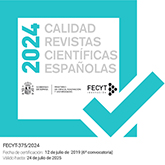A multidisplinary approach to tinnitus
DOI:
https://doi.org/10.3989/loquens.2018.051Keywords:
tinnitus, mechanisms, therapiesAbstract
Tinnitus, the conscious perception of a sound in absence of any source outside or inside the body, arises when the sub-cortical or cortical auditory system tries to compensate a deficit of peripheral information, due to aberrant brain plasticity, by increasing the spontaneous rate of spikes, altering the excitatory/inhibitory balance in synapses, or modifying the tonotopic distribution of frequencies in the primary auditory cortex. It consists of a pathology of the sub-cortical and cortical parts of the auditory system triggered by a malfunctioning of the peripheral part. Therefore, a correct approach to tinnitus should involve specialists in the different parts of the auditory system. Given the multidisciplinary nature of tinnitus, the contribution of five articles authored by different specialists from the clinical and research fields are included in this special issue.
Downloads
References
Baguley, D., Andersson, G., McFerran, D., y McKenna, L. (2013). Tinnitus. A multidisciplinary approach. Chichester, UK: Wiley. https://doi.org/10.1002/9781118783009
Chen, Z., Haykin, S., Eggermont, J. J., y Becker, S. (2007). Correlative learning. A basis for brain and adaptive systems. Hoboken, NJ: Wiley. https://doi.org/10.1002/9780470171455
Cobo, P. (2015). Tinnitus: mechanisms, measures and sound treatments. Loquens, 2, e024. https://doi.org/10.3989/loquens.2015.024
Durrant, J. D., y Dovrinic, J. H. (1984). Bases of the hearing science. Baltimore, MD: Willians & Wilkins.
Eggermont, J. J. (2012). The neuroscience of tinnitus. Oxford, UK: Oxford University Press. https://doi.org/10.1093/acprof:oso/9780199605606.001.0001
Jastreboff, P. J. (2015). 25 years of tinnitus retraining therapy. HNO, 63, 307–311. https://doi.org/10.1007/s00106-014-2979-1 PMid:25862626
Lerma, J. (2010). Cómo se comunican las neuronas. Madrid: CSIC & Libros de la Catarata.
Møller, A. R., Langguth, B., De Ridder, D., y Kleinjung, T. (2011). Textbook of tinnitus. New York: Springer Science + Business Media. https://doi.org/10.1007/978-1-60761-145-5
Pickles, J. O. (1988). An introduction to the physiology of hearing. London: Academic Press.
Vio, M. M., y Holme, R. H. (2005). Hearing loss and tinnitus: 250 million people and US$10 billion potential market. Drugs Discovery Today, 10, 1263–1265. https://doi.org/10.1016/S1359-6446(05)03594-4
Published
How to Cite
Issue
Section
License
Copyright (c) 2019 Consejo Superior de Investigaciones Científicas (CSIC)

This work is licensed under a Creative Commons Attribution 4.0 International License.
© CSIC. Manuscripts published in both the print and online versions of this journal are the property of the Consejo Superior de Investigaciones Científicas, and quoting this source is a requirement for any partial or full reproduction.
All contents of this electronic edition, except where otherwise noted, are distributed under a Creative Commons Attribution 4.0 International (CC BY 4.0) licence. You may read the basic information and the legal text of the licence. The indication of the CC BY 4.0 licence must be expressly stated in this way when necessary.
Self-archiving in repositories, personal webpages or similar, of any version other than the final version of the work produced by the publisher, is not allowed.














